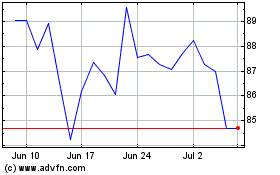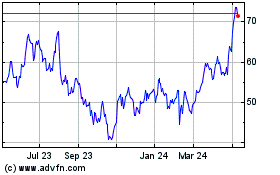Siemens and Bombardier in Talks to Form Train Joint Ventures -- Update
July 21 2017 - 4:06PM
Dow Jones News
By Ben Dummett and Jacquie McNish
Siemens AG and Bombardier Inc. are in advanced to talks to
combine their train-making businesses, according to people familiar
with the matter, as they aim to fend off stiffer competition from
consolidating rivals in China.
Germany's Siemens, one of the world's biggest industrial
conglomerates, and Canada's Bombardier, which is also a major plane
maker, are in advance discussions to fold their train operations
into two separate joint ventures. One unit, controlled by Siemens,
would hold the signaling operations of the two companies. The
second, which Bombardier would majority own, would oversee the
rolling-stock operations. Signaling equipment is used to keep
trains clear of each other and rolling stock centers on train
manufacturing.
A spokesman for Siemens declined to comment.
The combined joint ventures would have about EUR15 billion of
annual sales based on 2016 results of both firms' train divisions,
according to one person familiar with the discussions.
Talks are expected to conclude as early as next month, one of
the people said. The discussions were previously reported by
Bloomberg.
The companies expect to reach a deal in the next couple of
weeks, but one person familiar with the negotiations said there are
still some key issues that need to be resolved. As in all complex
merger negotiations, talks could collapse without an agreement.
The talks come at a time when the 2015 merger of Chinese train
makers CSR Corp. and China CNR is forcing rivals to gain scale as a
means to cut costs and access additional customers to boost revenue
and profit. In 2016, Bombardier 's transportation business reported
revenue of $7.57 billion, down almost 9% from the year-ago period.
Earnings before interest and taxes, a profit measure, was also
lower year over year. Siemens' train business has fared better, as
revenue and profit for the fiscal year ended Sept. 30, 2016, grew.
Still, orders fell 23% year over year.
Siemens is the leading supplier of train-signaling equipment,
accounting for about 25% of the global market, compared with
Bombardier's estimated 10% share, according to a report this week
by National Bank of Canada. The report said overlap between the two
companies' rolling-stock businesses could "present some challenges"
with competition authorities. The train-manufacturing arms of
Bombardier and Siemens both are currently based in Germany where
the two rank as the country's largest suppliers.
Bombardier had signaled as far back as 2015 that it was
considering a possible joint venture as part of potential
participation in the consolidation of the sector. At the same time,
the company has always stressed that it wouldn't sell the train
business outright. Bombardier has long maintained that the train
division is attractive as it counterbalances the aerospace
division. It tends to perform better during economic downturns,
when governments increase spending on rail and other infrastructure
projects, and demand for aircraft falters. The opposite is often
true during times of economic expansion.
--Christopher Alessi contributed to this article.
Write to Ben Dummett at ben.dummett@wsj.com and Jacquie McNish
at Jacquie.McNish@wsj.com
(END) Dow Jones Newswires
July 21, 2017 15:51 ET (19:51 GMT)
Copyright (c) 2017 Dow Jones & Company, Inc.
Bombardier (TSX:BBD.B)
Historical Stock Chart
From Mar 2024 to Apr 2024

Bombardier (TSX:BBD.B)
Historical Stock Chart
From Apr 2023 to Apr 2024
